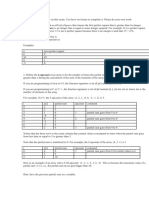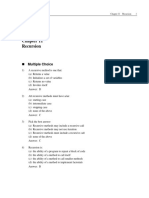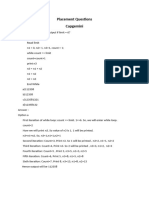0 ratings0% found this document useful (0 votes)
15 viewsIntroduction To Java Programming
Uploaded by
Lujain AljehaniCopyright
© © All Rights Reserved
We take content rights seriously. If you suspect this is your content, claim it here.
Available Formats
Download as PDF, TXT or read online on Scribd
0 ratings0% found this document useful (0 votes)
15 viewsIntroduction To Java Programming
Uploaded by
Lujain AljehaniCopyright
© © All Rights Reserved
We take content rights seriously. If you suspect this is your content, claim it here.
Available Formats
Download as PDF, TXT or read online on Scribd
You are on page 1/ 1
Introduction to Java Programming, Includes Data
Structures, Eleventh Edition, Y. Daniel Liang
This quiz is for students to practice. A large number of additional quiz is available for
instructors using Quiz Generator from the Instructor's Resource Website. Videos for Java,
Python, and C++ can be found at https://yongdanielliang.github.io/revelvideos.html.
Chapter 18 Recursion
Please send suggestions and errata to Dr. Liang at y.daniel.liang@gmail.com.
Indicate which book and edition you are using. Thanks!
Section 18.2 Example: Factorials
18.1 Which of the following statements are true?
A. Every recursive method must have a base case or a stopping condition.
B. Every recursive call reduces the original problem, bringing it increasingly closer to a
base case until it becomes that case.
C. Infinite recursion can occur if recursion does not reduce the problem in a manner that
allows it to eventually converge into the base case.
D. Every recursive method must have a return value.
E. A recursive method is invoked differently from a non-recursive method.
Your answer is correct
18.2 Fill in the code to complete the following method for computing factorial.
/** Return the factorial for a specified index */
public static long factorial(int n) {
if (n == 0) // Base case
return 1;
else
return _____________; // Recursive call
}
A. n * (n - 1)
B. n
C. n * factorial(n - 1)
D. factorial(n - 1) * n
Your answer is correct
18.3 What are the base cases in the following recursive method?
public static void xMethod(int n) {
if (n > 0) {
System.out.print(n % 10);
xMethod(n / 10);
}
}
A. n > 0
B. n <= 0
C. no base cases
D. n < 0
Your answer is correct
18.4 Analyze the following recursive method.
public static long factorial(int n) {
return n * factorial(n - 1);
}
A. Invoking factorial(0) returns 0.
B. Invoking factorial(1) returns 1.
C. Invoking factorial(2) returns 2.
D. Invoking factorial(3) returns 6.
E. The method runs infinitely and causes a StackOverflowError.
Your answer is correct
18.5 How many times is the factorial method in Listing 18.1 invoked for
factorial(5)?
A. 3
B. 4
C. 5
D. 6
Your answer is correct
Section 18.3 Example: Fibonacci Numbers
18.6 Which of the following statements are true?
A. The Fibonacci series begins with 0 and 1, and each subsequent number is the sum of
the preceding two numbers in the series.
B. The Fibonacci series begins with 1 and 1, and each subsequent number is the sum of
the preceding two numbers in the series.
C. The Fibonacci series begins with 1 and 2, and each subsequent number is the sum of
the preceding two numbers in the series.
D. The Fibonacci series begins with 2 and 3, and each subsequent number is the sum of
the preceding two numbers in the series.
Your answer is correct
18.7 How many times is the fib method in Listing 18.2 invoked for fib(5)?
A. 14
B. 15
C. 25
D. 31
E. 32
Your answer is correct
Click here to show an explanation
18.8 Fill in the code to complete the following method for computing a Fibonacci
number.
public static long fib(long index) {
if (index == 0) // Base case
return 0;
else if (index == 1) // Base case
return 1;
else // Reduction and recursive calls
return __________________;
}
A. fib(index - 1)
B. fib(index - 2)
C. fib(index - 1) + fib(index - 2)
D. fib(index - 2) + fib(index - 1)
Your answer is correct
Section 18.4 Problem Solving Using Recursion
18.9 In the following method, what is the base case?
static int xMethod(int n) {
if (n == 1)
return 1;
else
return n + xMethod(n - 1);
}
A. n is 1.
B. n is greater than 1.
C. n is less than 1.
D. no base case.
Your answer is correct
18.10 What is the return value for xMethod(4) after calling the following method?
static int xMethod(int n) {
if (n == 1)
return 1;
else
return n + xMethod(n - 1);
}
A. 12
B. 11
C. 10
D. 9
Your answer is correct
Click here to show an explanation
18.11 Fill in the code to complete the following method for checking whether a
string is a palindrome.
public static boolean isPalindrome(String s) {
if (s.length() <= 1) // Base case
return true;
else if _____________________________
return false;
else
return isPalindrome(s.substring(1, s.length() - 1));
}
A. (s.charAt(0) != s.charAt(s.length() - 1)) // Base case
B. (s.charAt(0) != s.charAt(s.length())) // Base case
C. (s.charAt(1) != s.charAt(s.length() - 1)) // Base case
D. (s.charAt(1) != s.charAt(s.length())) // Base case
Your answer is correct
18.12 Analyze the following code:
public class Test {
public static void main(String[] args) {
int[] x = {1, 2, 3, 4, 5};
xMethod(x, 5);
}
public static void xMethod(int[] x, int length) {
System.out.print(" " + x[length - 1]);
xMethod(x, length - 1);
}
}
A. The program displays 1 2 3 4 6.
B. The program displays 1 2 3 4 5 and then raises an
ArrayIndexOutOfBoundsException.
C. The program displays 5 4 3 2 1.
D. The program displays 5 4 3 2 1 and then raises an
ArrayIndexOutOfBoundsException.
Your answer is correct
Click here to show an explanation
Section 18.5 Recursive Helper Methods
18.13 Fill in the code to complete the following method for checking whether a
string is a palindrome.
public static boolean isPalindrome(String s) {
return isPalindrome(s, 0, s.length() - 1);
}
public static boolean isPalindrome(String s, int low, int high) {
if (high <= low) // Base case
return true;
else if (s.charAt(low) != s.charAt(high)) // Base case
return false;
else
return _______________________________;
}
A. isPalindrome(s)
B. isPalindrome(s, low, high)
C. isPalindrome(s, low + 1, high)
D. isPalindrome(s, low, high - 1)
E. isPalindrome(s, low + 1, high - 1)
Your answer is correct
18.14 Fill in the code to complete the following method for sorting a list.
public static void sort(double[] list) {
___________________________;
}
public static void sort(double[] list, int high) {
if (high > 1) {
// Find the largest number and its index
int indexOfMax = 0;
double max = list[0];
for (int i = 1; i <= high; i++) {
if (list[i] > max) {
max = list[i];
indexOfMax = i;
}
}
// Swap the largest with the last number in the list
list[indexOfMax] = list[high];
list[high] = max;
// Sort the remaining list
sort(list, high - 1);
}
}
A. sort(list)
B. sort(list, list.length)
C. sort(list, list.length - 1)
D. sort(list, list.length - 2)
Your answer is correct
18.15 Fill in the code to complete the following method for binary search.
public static int recursiveBinarySearch(int[] list, int key) {
int low = 0;
int high = list.length - 1;
return __________________________;
}
public static int recursiveBinarySearch(int[] list, int key,
int low, int high) {
if (low > high) // The list has been exhausted without a
match
return -low - 1; // Return -insertion point - 1
int mid = (low + high) / 2;
if (key < list[mid])
return recursiveBinarySearch(list, key, low, mid - 1);
else if (key == list[mid])
return mid;
else
return recursiveBinarySearch(list, key, mid + 1, high);
}
A. recursiveBinarySearch(list, key)
B. recursiveBinarySearch(list, key, low + 1, high - 1)
C. recursiveBinarySearch(list, key, low - 1, high + 1)
D. recursiveBinarySearch(list, key, low, high)
Your answer is correct
Section 18.7 Tower of Hanoi
18.16 How many times is the recursive moveDisks method invoked for 3 disks?
A. 3
B. 7
C. 10
D. 14
Your answer is correct
18.17 How many times is the recursive moveDisks method invoked for 4 disks?
A. 5
B. 10
C. 15
D. 20
Your answer is correct
18.18 Analyze the following two programs:
A:
public class Test {
public static void main(String[] args) {
xMethod(5);
}
public static void xMethod(int length) {
if (length > 1) {
System.out.print((length - 1) + " ");
xMethod(length - 1);
}
}
}
B:
public class Test {
public static void main(String[] args) {
xMethod(5);
}
public static void xMethod(int length) {
while (length > 1) {
System.out.print((length - 1) + " ");
xMethod(length - 1);
}
}
}
A. The two programs produce the same output 5 4 3 2 1.
B. The two programs produce the same output 1 2 3 4 5.
C. The two programs produce the same output 4 3 2 1.
D. The two programs produce the same output 1 2 3 4.
E. Program A produces the output 4 3 2 1 and Program B prints 4 3 2 1 1 1 .... 1
infinitely.
Your answer is correct
Click here to show an explanation
Section 18.8 Case Study: Fractals
18.19 In LiveExample 18.9, to draw three smaller triangles recursively, the program
invokes:
A. displayTriangles(order - 1, p1, p12, p31);
B. displayTriangles(order - 1, p12, p2, p23);
C. displayTriangles(order - 1, p31, p23, p3);
D. displayTriangles(order - 1, p12, p23, p31);
Your answer is correct
Click here to show an explanation
Section 18.9 Recursion versus Iteration
18.20 Which of the following statements are true?
A. Recursive methods run faster than non-recursive methods.
B. Recursive methods usually take more memory space than non-recursive methods.
C. A recursive method can always be replaced by a non-recursive method.
D. In some cases, however, using recursion enables you to give a natural,
straightforward, simple solution to a program that would otherwise be difficult to
solve.
Your answer is correct
Section 18.10 Tail Recursion
18.21 Analyze the following functions;
public class Test1 {
public static void main(String[] args) {
System.out.println(f1(3));
System.out.println(f2(3, 0));
}
public static int f1(int n) {
if (n == 0)
return 0;
else {
return n + f1(n - 1);
}
}
public static int f2(int n, int result) {
if (n == 0)
return result;
else
return f2(n - 1, n + result);
}
}
A. f1 is tail recursion, but f2 is not
B. f2 is tail recursion, but f1 is not
C. f1 and f2 are both tail recursive
D. Neither f1 nor f2 is tail recursive
Your answer is correct
18.22 Show the output of the following code
public class Test1 {
public static void main(String[] args) {
System.out.println(f2(2, 0));
}
public static int f2(int n, int result) {
if (n == 0)
return 0;
else
return f2(n - 1, n + result);
}
}
A. 0
B. 1
C. 2
D. 3
Your answer is correct
You might also like
- Data Structures and Abstractions with Java 4th Edition Carrano Test Bank download pdf100% (32)Data Structures and Abstractions with Java 4th Edition Carrano Test Bank download pdf42 pages
- Data Structures and Abstractions with Java 4th Edition Carrano Test Bank - Quickly Download And Never Miss Important Content100% (4)Data Structures and Abstractions with Java 4th Edition Carrano Test Bank - Quickly Download And Never Miss Important Content34 pages
- Data Structures and Abstractions with Java 4th Edition Carrano Test Bank download100% (2)Data Structures and Abstractions with Java 4th Edition Carrano Test Bank download45 pages
- Access Data Structures and Abstractions with Java 4th Edition Carrano Test Bank All Chapters Immediate PDF Download100% (8)Access Data Structures and Abstractions with Java 4th Edition Carrano Test Bank All Chapters Immediate PDF Download43 pages
- Immediate download Data Structures and Abstractions with Java 4th Edition Carrano Test Bank all chapters100% (4)Immediate download Data Structures and Abstractions with Java 4th Edition Carrano Test Bank all chapters48 pages
- Data Structures and Abstractions with Java 4th Edition Carrano Test Bankdownload100% (6)Data Structures and Abstractions with Java 4th Edition Carrano Test Bankdownload48 pages
- Data Structures and Abstractions with Java 4th Edition Carrano Test Bank - Latest Version Can Be Downloaded Immediately100% (3)Data Structures and Abstractions with Java 4th Edition Carrano Test Bank - Latest Version Can Be Downloaded Immediately46 pages
- Data Structures and Abstractions with Java 4th Edition Carrano Test Bank download100% (3)Data Structures and Abstractions with Java 4th Edition Carrano Test Bank download40 pages
- Data Structures and Abstractions with Java 4th Edition Carrano Test Bank - Download Now And Never Miss A Chapter100% (6)Data Structures and Abstractions with Java 4th Edition Carrano Test Bank - Download Now And Never Miss A Chapter34 pages
- Computer Applications Cisce Academic Year: 2023-2024 (English Medium) Date & Time: 13th March 2024, 11:00 AmNo ratings yetComputer Applications Cisce Academic Year: 2023-2024 (English Medium) Date & Time: 13th March 2024, 11:00 Am22 pages
- Free Access to Data Structures and Abstractions with Java 4th Edition Carrano Test Bank Chapter Answers100% (21)Free Access to Data Structures and Abstractions with Java 4th Edition Carrano Test Bank Chapter Answers19 pages
- Data Structures and Abstractions with Java 4th Edition Carrano Test Bank pdf download100% (3)Data Structures and Abstractions with Java 4th Edition Carrano Test Bank pdf download44 pages
- Data Structures and Abstractions with Java 4th Edition Carrano Test Bankpdf download100% (10)Data Structures and Abstractions with Java 4th Edition Carrano Test Bankpdf download46 pages
- Data Structures and Abstractions with Java 4th Edition Carrano Test Bank pdf download100% (3)Data Structures and Abstractions with Java 4th Edition Carrano Test Bank pdf download25 pages
- Accenture Preaperation Coding Question SetNo ratings yetAccenture Preaperation Coding Question Set13 pages
- 614b95aeb067a_5e971aec4a3f7_GIN221_FL_2017-2018_FLNo ratings yet614b95aeb067a_5e971aec4a3f7_GIN221_FL_2017-2018_FL5 pages
- Computer Application ICSE_Sample Paper 2_X_2024-25No ratings yetComputer Application ICSE_Sample Paper 2_X_2024-256 pages
- CL 10 - COMP APP - QUESTION PAPER-Answer keyNo ratings yetCL 10 - COMP APP - QUESTION PAPER-Answer key11 pages
- Anand Nagar Ms Monika Tripathi CLASS X CFQ ANANDNAGARNo ratings yetAnand Nagar Ms Monika Tripathi CLASS X CFQ ANANDNAGAR7 pages
- Homework Assignments - Week 2 (Flow Control) : ClassroomNo ratings yetHomework Assignments - Week 2 (Flow Control) : Classroom4 pages
- Advanced C++ Interview Questions You'll Most Likely Be AskedFrom EverandAdvanced C++ Interview Questions You'll Most Likely Be AskedNo ratings yet
- Pyronix Enforcer DIGIWIFISet Up Data SheetNo ratings yetPyronix Enforcer DIGIWIFISet Up Data Sheet2 pages
- What Is Boxing and Unboxing in C#?: StructNo ratings yetWhat Is Boxing and Unboxing in C#?: Struct3 pages
- Animal Detection System in Farm Areas: IjarcceNo ratings yetAnimal Detection System in Farm Areas: Ijarcce5 pages
- Keysight E4980A/AL Precision LCR Meter: User's GuideNo ratings yetKeysight E4980A/AL Precision LCR Meter: User's Guide529 pages
- User's Manual: Thanks For Choosing HavitNo ratings yetUser's Manual: Thanks For Choosing Havit1 page
- TVL Computer System Servicing Ethernet Wiring Standard BasisNo ratings yetTVL Computer System Servicing Ethernet Wiring Standard Basis25 pages
- PO-2033C LCD Panel Controller Board Support TTL & LVDS Panel For 4.3" 22" Digital LCD PanelNo ratings yetPO-2033C LCD Panel Controller Board Support TTL & LVDS Panel For 4.3" 22" Digital LCD Panel12 pages
- Get Essentials of Wireless Mesh Networking 1st Edition Steve Methley free all chapters100% (7)Get Essentials of Wireless Mesh Networking 1st Edition Steve Methley free all chapters81 pages

























































































